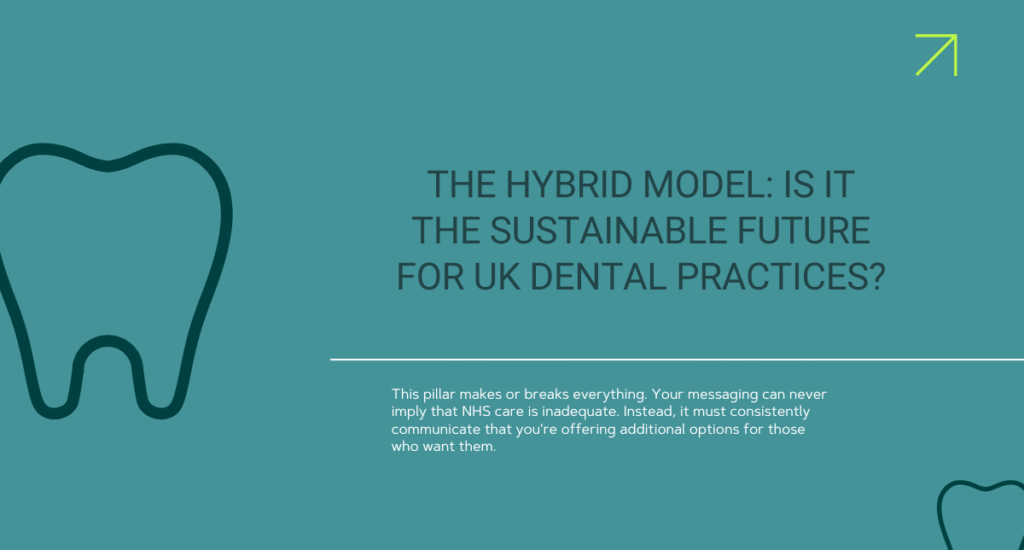The dental hybrid model is not a passing trend; for many, it’s the key to long-term sustainability in the UK. It requires careful planning, impeccable communication, and a patient-centric approach. But the reward—a profitable, fulfilling, and future-proof practice—is well worth the effort.
The Dental Hybrid Model: A Guide for UK Practices Balancing NHS and Private Care
For UK dental practice owners, the landscape has never been more challenging. Rising costs, stringent NHS contracts, and increasing patient expectations are squeezing profitability. Many practitioners feel trapped between the stability of the NHS and the potential of private practice. The solution? A strategically implemented dental hybrid model.
This comprehensive guide is designed for NHS dental practices across the UK considering a transition to a hybrid approach. We will explore what a hybrid model is, its undeniable benefits, and a step-by-step framework for integration that protects your existing patient base while unlocking new revenue.
What is a Hybrid Dental Model?
A hybrid dental model is a practice structure that maintains an NHS contract while also offering private dental treatments. Unlike a full private transition, it allows you to continue serving your NHS patients while providing enhanced options for those willing and able to invest in premium care. It’s about offering choice and building a more resilient dental business.
Key Benefits of a Hybrid Model for Your UK Practice
- Financial Stability & Growth: Diversify your income streams. Reduce reliance on NHS funding and tap into the growing demand for private dentistry in the UK.
- Enhanced Patient Care: Offer treatments and materials that aren’t available under the NHS, such as teeth whitening, cosmetic bonding, implantology, and advanced orthodontics.
- Improved Job Satisfaction: Regain clinical freedom, spend more time on complex cases, and reduce the burnout associated with NHS targets.
- Future-Proofing: Create a practice that can adapt to changes in NHS funding and patient demand.
How to Successfully Transition to a Hybrid Model: A Step-by-Step Guide
Step 1: Conduct a Deep Practice Analysis
Before you begin, understand your starting point. Analyse your patient demographics, current profitability, and the potential demand for private services in your area—especially for practices in competitive areas like London.
Step 2: Choose Your Initial Private Services Wisely
Start with services that have clear appeal and are easy to integrate. Good starting points include:
- Hygiene Programs: Offer “premium hygiene” with Airflow or guided biofilm therapy.
- Cosmetic Treatments: Teeth whitening is a high-demand, low-barrier entry point.
- Premium Materials: Provide the option of tooth-coloured fillings on posterior teeth or higher-strength crowns.
Step 3: Develop a Crystal-Clear Communication Strategy
This is the most critical step. Your team must be trained to present private options as an enhancement, not a replacement. The language should focus on choice and benefits.
- Scripting: Arm your reception team with phrases like, “As well as your NHS examination, we also offer an advanced oral health assessment which includes…”
- In-Practice Marketing: Use posters, brochures, and digital screens in your waiting room to subtly promote your new private services.
- Online Presence: Update your website with dedicated pages for your private dentist services. Ensure your Google Business Profile accurately reflects your offering.
Step 4: Train Your Team
A hybrid model only works if your whole team believes in it. Invest in training for dentists, nurses, and receptionists so everyone can confidently explain the value of your new services.
Common Challenges and How to Overcome Them
- Patient Confusion: Solved by consistent, clear messaging across all touchpoints.
- Staff Resistance: Solved by involving the team in the planning process and highlighting the benefits for them (e.g., more varied work).
- Marketing the Change: Solved by partnering with a specialist dental marketing agency (like us!) that understands the UK market.
Finally is a Hybrid Future Right for You?
The dental hybrid model is not a passing trend; for many, it’s the key to long-term sustainability in the UK. It requires careful planning, impeccable communication, and a patient-centric approach. But the reward—a profitable, fulfilling, and future-proof practice—is well worth the effort.

